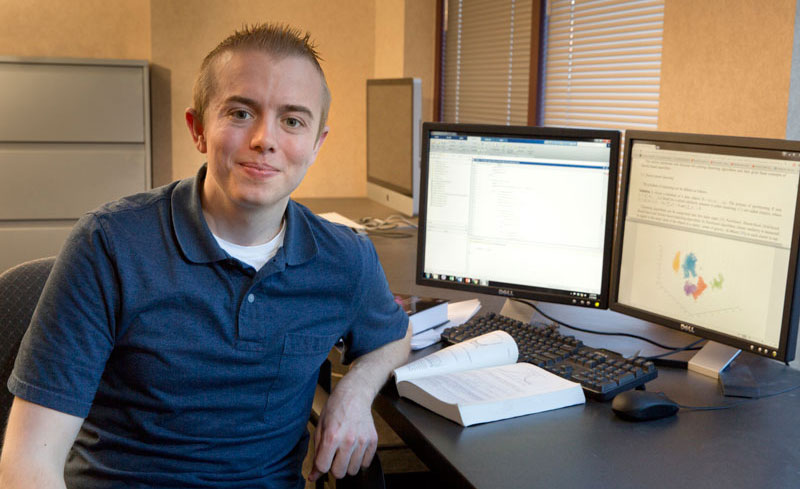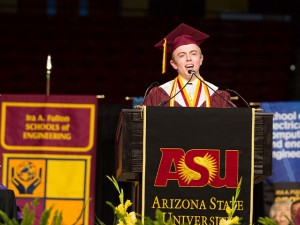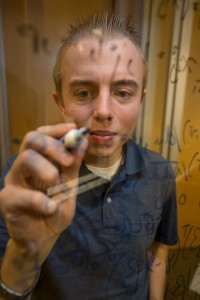
Doctoral student combines biomedical and industrial engineering to develop better brain diagnostics

Above: Nathan Gaw is currently an industrial engineering doctoral student. He previously earned bachelor’s and master’s degrees in biomedical engineering from Arizona State University. Photographer: Nick Narducci/ASU
Research opportunities, industry partnerships and world-class faculty provide Fulton Schools industrial engineering graduate researcher associate Nathan Gaw with the best tools to conduct high-impact brain data analysis research.
A plane ride, a magazine and a curious mind led Nathan Gaw to engineering.
Before a flight from Arizona to Chicago, Gaw picked up a National Geographic magazine that had a feature on neuroprosthetics. He read it once, then again and kept re-reading it until the plane landed.
“It was about using engineering to help translate really complicated signals from the brain, which I believe is the last frontier of the human body,” Gaw said. “I was fascinated by how you can use technology and engineering to translate the brain’s complex signals.”
This moment was more influential to Gaw’s decision to pursue engineering than his general interest in math and science and growing up with a father in engineering. Before the pivotal trip he hesitated to pursue engineering because it felt like the obvious choice, but after learning what engineering could lead to — something clicked.
When college acceptance letters started coming in, it wasn’t difficult for Gaw to choose Arizona State University. Though he was accepted into the University of Pennsylvania, an Ivy League school, among other good options, Gaw thought ASU provided the best opportunity for research as well as academics.
“I could have studied really hard at UPenn and never gotten my hands very wet with research, but ASU gives you more room to get involved in research and actually apply what you’re learning on top of rigorous academics,” Gaw said.
Upon choosing biomedical engineering as his undergraduate field of study, Gaw took advantage of the Ira A. Fulton Schools of Engineering professors’ willingness to include undergraduates in their research. He participated in research opportunities wherever he could, including in the Neural Control of Movement Laboratory, led by Marco Santello, a biomedical engineering professor and director of the School of Biological and Health Systems Engineering.

Nathan Gaw was the student speaker at the Fulton Schools’ convocation ceremony after completing his undergraduate degree in spring 2013. Photographer: Jessica Hochreiter/ASU
After he completed his biomedical engineering bachelor’s degree, Gaw continued to study biomedical engineering for his master’s, working on research to discover the underlying neural mechanisms the brain uses to give commands to the hand.
Shift to industrial engineering facilitates advanced data interpretation
During his master’s degree studies, Gaw began to integrate industrial engineering into his biomedical engineering studies. Industrial engineering involves the use of math and engineering to improve processes and decision-making.
“Diagnostic data, such as results from an MRI, is very high dimensional, has high resolution and can be hard to interpret,” Gaw said. “I decided I wanted to go down the route of how to interpret this difficult data to better understand what parts of the brain are important for different brain diseases and help make better diagnostic decisions based on information from the image.”
His interest in pursuing industrial engineering to meet his research goals was piqued with his first industrial engineering course, Design of Experiments, that he took to meet an elective requirement for his master’s program.
The faculty allowed him to take additional industrial engineering classes while obtaining his biomedical engineering master’s degree, which led to his involvement in genetic database data analysis research under Jing Li, an industrial and computer engineering associate professor who became his Ph.D. advisor, and Teresa Wu, an industrial engineering professor.
When it came time to choose a doctoral industrial engineering program, Gaw said ASU’s high-impact research was one reason that made it a clear choice. The university’s collaboration with Mayo Clinic and Banner Health doctors and other industry partners provided excellent opportunities for his medical focus.
Gaw’s research involves developing theoretical methods to analyze data from a variety of applications and sources, and applying those methods by working directly with doctors to solve problems they have with their data. The theoretical and application approaches play off one another, for example, once Gaw helps a doctor solve a data problem, he thinks of how to use that solution to solve other problems.
So far in his research Gaw has been helping Mayo Clinic doctors use algorithms to analyze MRI and fMRI data to diagnose patients who have migraines, and using genetic and tissue contrast data to help diagnose tumors like glioblastoma brain tumors. Gaw has published academic papers with doctors based on his research, one of which received the 2015 Harold G. Wolff Award and another was submitted to Cephalalgia, a publication by the International Headache Society.

Nathan Gaw’s research helps doctors to better analyze clinical data to diagnose patients who suffer from migraines, glioblastoma brain tumors, and more. Photographer: Nick Narducci/ASU
Strong professors inspire interest in teaching
In addition to the high-impact research conducts through the industrial engineering program, Gaw thinks ASU’s program boasts world-class professors.
“Every professor you meet here is a superstar in their field,” Gaw said. “I have a class with a professor who has taught at other great universities like Georgia Institute of Technology and has more than 70,000 citations in his lifetime. He is known across the entire world. Another professor revolutionized transportation engineering and has highly impacted the way traffic is managed. The drive of the professors and the way they teach and do their research shows they love what they do and they’re very good at it.”
Gaw finds that along with how influential and smart they are, they’re also willing to help and connect with students.
“Professors are friendly and I feel comfortable stopping by their offices to pick their brains and ask questions about research, even if they’re not my advisor,” Gaw said.
Once Gaw finishes his dissertation in 2018 on methods of integrating different data sources to make a decision, he wants to become a trailblazing professor like those he’s learned from to pass on his knowledge at the intersection of medicine and engineering.
“I like to teach other people,” Gaw said. “As a professor you get to mentor one on one and teach others in a bigger setting. I get to learn from people I collaborate with and teach them the tricks from my domain. It’s fun to be a lifelong learner, and being a professor is one of the only jobs where you get paid to discover and explore.”
Media Contact
Monique Clement, [email protected]
480-727-1958
Ira A. Fulton Schools of Engineering



































